


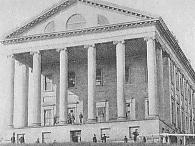
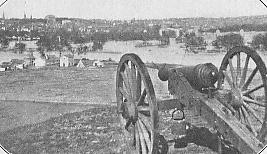
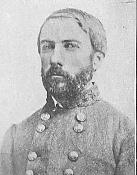
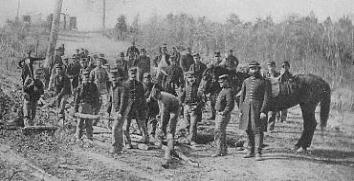
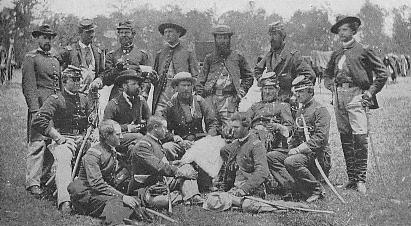
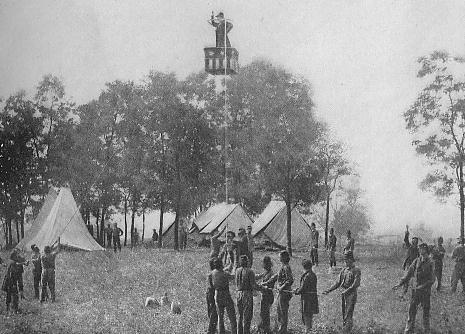
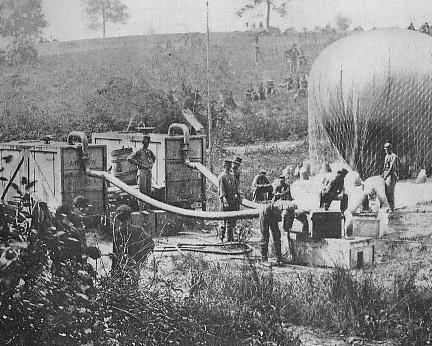

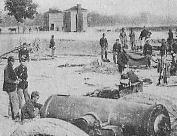
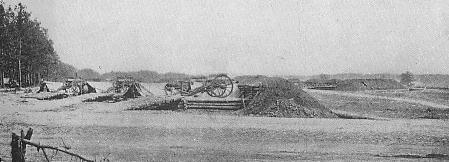
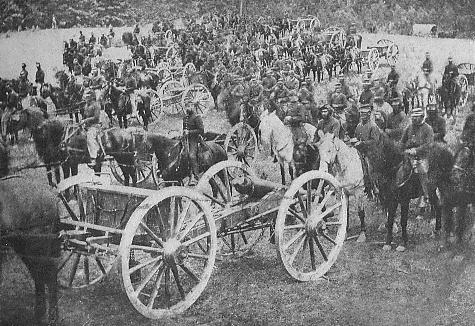
| From the book: "The Civil War Through the Camera" with "Elson's New History" In Sixteen Parts Comprising a Complete History of the Civil War Part Three by Henry W. Elson, Professor of History, Ohio University Published in 1912 by the Patriot Publishing Company, Springfield, Massachusetts Photographs from Chapter Three: "Fair Oaks.....In Sight of Richmond" To read Chapter Three, click on flags below |
| Ramparts that Baffled McClellan. Hasty fortifications of the Confederates at Yorktown. It was against such fortifications as these which Magruder had hastily reenforced with sand-bags, that McClellan spent a month preparing his heavy batteries. Magruder had far too few soldiers to man his long line of defenses properly, and his position could have been taken by a single determined attack. This rampart was occupied by the Confederate general, D. H. Hill, who had been the first to enter Yorktown in order to prepare it for siege. He was the last to leave it on the night of May 3, 1862. |
| Wrecked ordnance. Gun exploded by the Confederates on General Hill's rampart, Yorktown. Although the Confederates abandoned 200 pieces of ordnance at Yorktown, they were able to render most of them useles before leaving. Hill succeeded in terrorizing the Federals with grap-shot, and some of this was left behind. After the evacuation, the ramparts were overrun by Union trophy seekers. The soldier resting his hands upon his musket is one of the Zouaves whose bright and novel uniforms were so conspicuous early in the war. This spot was directly on the line of the British fortification of 1781. |
| Another voiceless gun. Confederate ramparts southeast of Yorktown. A 32-pounder Navy gun which had been burst, wrecking its embrasure. The Federal soldier seated on the sand-bags is on guard-duty to prevent camp-followers from looting the vacant fort. |
| The missing rifle. Extensive sand-bag fortifications of the Confederates at Yorktown. The shells and carriage were left behind by the Confederates, but the rifled gun to which they belonged was taken along in the retreat. Such pieces as they could not remove they spiked. |
| Guns the union lost and recovered. A two-gun Confederate battery in the entrenchments south of Yorktown. The near gun is a 32-pounder Navy; the far one, a 24-pounder siege-piece. More than 3,000 pieces of Naval ordnance fell into the hands of the Confederates early in the war, through the ill-advised and hasty abandonment of Norfolk Navy Yard by the Federals. Many of these guns did service at yorktown and subsequently on the James River against the Union. |
| The Confederate Command of the River. Battery Magruder, Yorktown. Looking north up the river, four of the five 8-inch Columbiads composing this section of the battery are visible. The grape-shot and spherical shells, which had been gathered in quantities to prevent the Federal fleet from passing up the river, were abandoned on the hasty retreat of the Confederates, the guns being spiked. The vessels in the river are transport ships, with the exception of the frigate just off shore. |
| Confederate Capital, Richmond, Virginia |
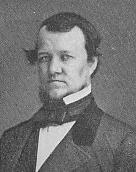
| General G. W. Smith, CSA |
| General D. H. Hill, CSA |
| View of the City of Richmond |
| The advance that became a retreat. Here, almost within sight of Richmond, we see McCLellan's soldiers preparing the way for the passage of the army and its supplies. The soil along the Chickahominy was so marshy that, in order to move the supply trains and artillery from the base, across the river to the army, corduroy approaches to the bridges had to be built. It was well that the men got this early practice in road-building. McClellan was able to unite the divided wings of the army almost at will. |
| "Regulars" near Fair Oaks, officers of McClellan's Horse Artillery Brigade. These trained soldiers lived up to the promise in their firm-set features. Major Hays and five of his Lieutenants and Captains here, Pennington, Tidball, Hains, Robertson and Barlow had, by 1865, become general officers. From left to right (standing) are Edward Pendleton, A. C. M. Pennington, Henry Benson, H. M. Gibson, J. M. Wilson, J. C. Tidball, W. N. Dennison; (sitting) P. C. Hains, H. C. Gibson, William Hays, J. M. Robertson, J. W. Barlow; (on ground) R. H. Chapin, Robert Clarke, A. C. Vincent. |
| Professor Lowe in his balloon. As soon as Professor Lowe's balloon soars above the top of the trees the Confederate batteries will open upon him, and for the next few moments shells and bullets from the shrapnel will be bursting and whistling about his ears. Then he will pass out of the danger-zone to an altitude beyond the reach of the Confederate artillery. After the evacuation of Yorktown, May 4, 1862, Professor Lowe, who had been making daily observations from his balloon, followed McClellan's divisions, which was to meet Longstreet next day at Williamsburg. On reaching the fortifications of the abandoned city, Lowe directed the men who were towing the still inflated balloon in which he was riding to scale the corner of the fort nearest to his old camp, where the last gun had been fired the night before. This fort had devoted a great deal of effort to attempting to damage the too inquisitive balloon, and a short time previously one of the best Confederate guns had burst, owing to over-charging and too great an elevation to reach the high altitude. The balloonist had witnessed the explosion and a number of gunners had been killed and wounded within his sight. His present visit was in order to touch and examine the pieces and bid farewell to what he then looked upon as a departed friend. This is indicated as the same gun shown in photo above. |
| The photograph the balloonist recognized forty-eight years after. "When I saw the photograph showing my inflation of the balloon Intrepid to reconnoiter the battle of Fair Oaks," wrote Professor T. S. C. Lowe in the American review of Reviews for February, 1911, "it surprised me very much indeed. Anyone examining the picture will see my hand at the extreme right, resting on the network, where I was measuring the amount of gas already in the balloon, preparatory to completing the inflation from gas in the smaller balloon in order that I might ascent to a greater height. This I did within a space of five minutes, saving a whole hour aaat the most vital point of the battle." It truly is remarkable that Professor Lowe should have seen and recognized, nearly half a century afterward, this photograph taken at one of the most critical moments of his life. |
| The slaughter field at Fair Oaks. Over this ground the fiercest fighting of the two days' battle took place, on May 31, 1862. Some 400 soldiers were buried here, where they fell, and their hastily dug graves appear plainly in the picture. In the redoubt seen just beyond the two houses was the center of the Federal line of battle, equi-distant, about a mile and a half, from both Seven Pines and Fair Oaks. The entrenchments near these farm dwellings were begun on May 28th by Casey's Division, 4th Corps. There was not time to finish them before the Confederate attack opened the battle, and the artillery of Casey's Division was hurriedly placed in position behind the incomplete works. |
Elson's New History of the Civil War - Chapter 3, Fair Oaks (Seven Pines)
Battle of Seven Pine Index
Battle of Seven Pine Index
| The unfinished redoubt. Here we see the inside of the redoubt at the left background of the picture above. The scene is just before the battle and picks and shovels were still busy throwing up the embankments to strengthen the center of the Federal defense. Casey's artillery was being hurriedly brought up. In the background General Sickles' Brigade appears drawn up in line of battle. When the Confederates first advanced, Casey's artillery did telling work, handsomely repelling the attack early in the afternoon of May 31st. Later in the day, Confederate sharp-shooters from vantage points in neighboring trees began to pick off the officers and the gunners and the redoubt had to be relinquished. The abandoned guns were turned against the retreating Federals. |
| The "redhot battery." On the afternoon of May 31st, at Fair Oaks, the Confederates were driving the Federal soldiers through the woods in disorder when this battery (McCarthy's) together with Miller's battery opened up with so continuous and severe a fire that the Federals were able to make a stand and hold their own for the rest of the day. The guns grew so hot from constant firing that it was only with the greatest care that they could be swabbed and loaded. These earthworks were thrown up for McCarthy's Battery, Company C, 1st Pennsylvania Artillery, near Savage's Station. The soldiers nicknamed it the "Redhot Battery." |
| "Flying Artillery" in the attempt on Richmond. The cannoneers who kept up with the cavalry, in this swiftest branch of the service each man rides horseback. Here are drawn up Harry Benson's Battery A, of the Second United States Artillery, and Haratio Gates GIbson's Batteries C and G, combined of the Third United States Artillery, near Fair Oaks, Virginia. They arrived just a short time too late to participate in the battle. They were in Yorktown and the Seven Days. |
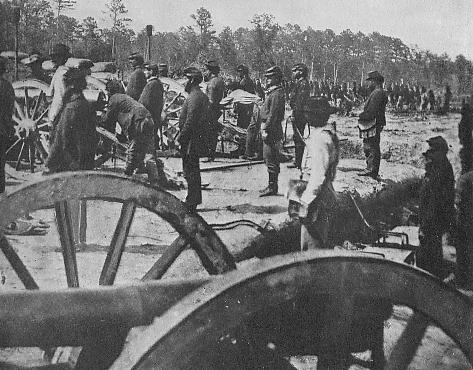
| Aiming the guns at Fair Oaks. Here we see the beginning of the lull in the fighting of the second day at Fair Oaks, which it has been asserted led to a fatal delay and the ruin of McClellan's Peninsula Campaign. The first day's battle at Fair Oaks, May 31, 1862, was decidedly a Federal reverse which would have developed into a rout had not Sumner, crossing his troops on the perilous Grapevine Bridge, come up in time to rally the retreating men. Here we see some of them within the entrenchments at Fair Oaks Station on the Richmond and York River Railroad. The order will soon come to cease firing at the end of the second day's fighting, the result of which was to drive the Confederates back to Richmond. McClellan did not pursue. The heavy rainstorm on the night of May 30th had made the movement of artillery extremely difficult, and McClellan waited to complete the bridges and build entrenchments before advancing. This delay gave the Confederates time to reorganize their forces and place them under the new commander, Robert E. Lee, who, while McClellan lay inactive, effected a junction with "Stonewall" Jackson. |
| Text is just as it appears in book, including spelling & punctuation. Nancy Brister |
